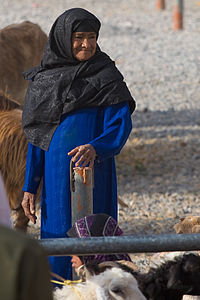- Women in Oman
-
 An Omani woman at a goat market.
An Omani woman at a goat market.
The women of Oman are citizens of a country that is described as "one of the most advanced countries in the Persian Gulf region as far as women's rights are concerned". The government of Oman has been promoting women's education since 1970,[1] and Omani women are described as having a "more active and visible role" in society compared to other regions in the Arabian Peninsula.[2]
Omani women are the beneficiaries of the Omani government's efforts to provide and to safeguard their "political, social and economic rights", including their development, empowerment, health, and vocational and personal welfare. Their development and protection from illness and discrimination are also supported by the Ministry of Health of Oman and the United Nations Population Fund (UNFPA). Women's employment, in turn, is supported by Oman's Ministry of Social Development, in cooperation with UNFPA.[1]
In 2009, Sultan Qaboos declared 17 October to be Omani Women's Day, and the day is celebrated every year with various pro-female events.[3]
Contents
Attire
In general, the women of Oman may present themselves without a veil. Tribal Omani women, however, prefer to wear the burqa (facemask) and the abaya (black-colored cloak).[2] In addition, Omani women traditionally wear colorful dresses that are worn over the sirwal (trousers) and the lihaf (headdress). Their jewellery is generally made from silver and gold engraved with patterns, symbols, and calligraphy based on the Quran. Traditionally, Omani women wear the qurhaf as footwear, but modern-day women may wear Western-style shoes and sandals. For make-up, the women of Oman use natural and traditional cosmetic products, including Kohl as eyeliners or eye-enhancers, a mixture of the seeds of the prunus mahled and the flowers of the carthamus tincturius plant as moisturizers, and the indigo plant as a form of skin wash. For taking care of their hair, Omani women use oils from the seeds of the shoo plant, and the shampoo that is produced from the sidr and ipomoea nil plants. The women of Oman traditionally decorate their hands and feet with henna paint, particularly during wedding celebrations and other special occasions.[4]
Attitude
In general, the women of Oman are described as "not self-effacing" and "willing to talk to strangers, once the ice has been broken". Nonetheless, Omani women are Muslim women, entailing respect from Oman's menfolk.[5]
Labor and employment
Women reportedly hold 12 percent of senior government positions in Oman and make up over 40 percent of the civil service. In addition, women are widely active in Omani agriculture, particularly the rearing of livestock.[2]
Religion
Because of the nation's Muslim faith, the role of women in Oman is bound by Islam's "formal restrictions". However, in some Omani cities and towns, women are generally allowed to practice as teachers in the kuttab, or Islamic preschools.[5]
Family
Within the boundaries of the household and the family, Omani women are practitioners of authority and contribute as decision-makers, particularly with the implementation of "rites of passage". However, they have less privilege and authority outside the unit of the family.[5]
Politics
Since the 1990s, Omani women have been active participants in the politics of Oman.[5] Universal suffrage was instituted in 2003, and the election of that year saw two women elected to seats in the Omani Consultative Assembly (Majlis al-Shura). As of 2011, there are two female ministers in the Omani government: Dr Rawiyah bint Saud al Busaidiyah, Minister of Higher Education, and H.E. Dr Madeeha bint Ahmed bin Nassir al Shibaniyah, Minister of Education.[6] Another female appointee, Minister of Tourism Rajiha bint Abdulamir bin Ali al Lawati, died in early 2011.[7][8]
Oman was the first Arab nation to appoint a female ambassador, to the Netherlands, in 1999. It currently has two female ambassadors, to the United States (since 2005) and Germany (2009).
See also
- Rawya Saud Al Busaidi
- Culture of Oman
- Human trafficking in Oman
References
- ^ a b Vaidya, Sunil K. Oman 'regional pioneer for women's rights', March 9, 2008, gulfnews.org
- ^ a b c People of Oman, omaninfo.com
- ^ Gulf in the Media, 5 October 2011. Retrieved 2011-10-27.
- ^ National Dress – Women, omanet.om
- ^ a b c d Oman, Countries and Their Cultures, everyculture.com
- ^ Ministry of Information, Sultanate of Oman. Retrieved 8 September 2011.
- ^ Oman Economic Review. Retrieved 8 September 2011.
- ^ Andy in Oman. Retrieved 8 September 2011.
External links
- Grondahl, Mia. Not Without My Veil; Amongst the Women Of Oman, Film Info, Filmakers Library, 1994
Women in Asia Sovereign
states- Afghanistan
- Armenia
- Azerbaijan
- Bahrain
- Bangladesh
- Bhutan
- Brunei
- Burma (Myanmar)
- Cambodia
- People's Republic of China
- Cyprus
- East Timor (Timor-Leste)
- Egypt
- Georgia
- India
- Indonesia
- Iran
- Iraq
- Israel
- Japan
- Jordan
- Kazakhstan
- North Korea
- South Korea
- Kuwait
- Kyrgyzstan
- Laos
- Lebanon
- Malaysia
- Maldives
- Mongolia
- Nepal
- Oman
- Pakistan
- Philippines
- Qatar
- Russia
- Saudi Arabia
- Singapore
- Sri Lanka
- Syria
- Tajikistan
- Thailand
- Turkey
- Turkmenistan
- United Arab Emirates
- Uzbekistan
- Vietnam
- Yemen
States with limited
recognition- Abkhazia
- Nagorno-Karabakh
- Northern Cyprus
- Palestine
- Republic of China (Taiwan)
- South Ossetia
Dependencies and
other territories- Christmas Island
- Cocos (Keeling) Islands
- Hong Kong
- Macau
Categories:- Omani women
- History of Oman
Wikimedia Foundation. 2010.
